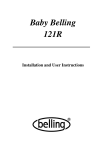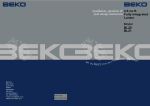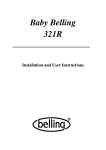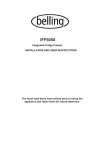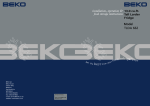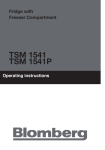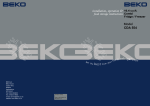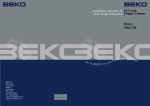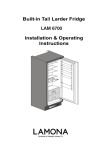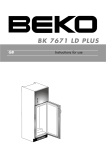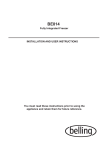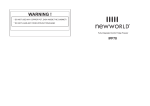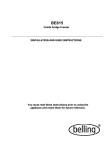Download Belling ILF800
Transcript
ILF800 Fully Integrated Larder INSTALLATION AND USER INSTRUCTIONS You must read these instructions prior to using the appliance and retain them for future reference. Contents Introduction & safety warnings...........................................................................2 Electrical requirements ......................................................................................3 Transportation instructions.................................................................................4 Installation instructions.......................................................................................5 Repositioning the door .......................................................................................6 Suggested arrangement of food in the larder fridge...........................................8 Temperature control and adjustment..................................................................9 Starting .............................................................................................................10 Defrosting.........................................................................................................10 Cleaning and care ............................................................................................11 Replacing the interior light bulb........................................................................12 Do's and don'ts.................................................................................................13 Problem solving/trouble shooting .....................................................................13 Installation instructions - detailed step by step .................................................14 Guarantee details .............................................................................................20 How to obtain service .......................................................................................21 Technical data ..................................................................................................22 Wiring diagram.................................................................................................23 Customer Care..................................................................................back cover Please keep this handbook for future reference, or for anyone else who may use the appliance. 1 Congratulations on your choice of a Belling quality Appliance which has been designed to give you service for many years. WARNING ! IMPORTANT ! DO NOT connect the appliance to the electricity supply until all packing and transit protectors have been removed. • Leave to stand for at least 4 hours before switching on to allow compressor oil to settle if transported horizontally. • If you are discarding an old refrigerator with a lock or latch fitted to the door, ensure that it is left in a safe condition to prevent the entrapment of children. • This fridge must only be used for its intended purpose i.e the storing of edible foodstuff. • Do not dispose of the appliance on a fire. At Belling, the care and protection of our environment is an ongoing commitment. This appliance which is among the latest range introduced is particularly environmentally friendly. Your appliance contains non CFC / HFC natural substances in the cooling system (Called R600a) and in the insulation(Called cyclopentane) which are potentially flammable if exposed to fire. Therefore, take care not to damage, the cooling circuit / pipes of the appliance in transportation and in use. In case of a damage do not expose the appliance to fire, potential ignition source and immediately ventilate the room where the appliance is situated. • We suggest you contact your local authority for disposal information and facilities available. • We do not recommend use of this appliance in an unheated, cold room. (E.g.: garage, conservatory, annex, shed, out-house etc.) • To obtain the best possible performance and trouble free operation from your appliance it is very important to carefully read these instructions. • On delivery, check to make sure that the product is not damaged and that all the parts and accessories are in perfect condition. • Ensure that the plug remains readily accessible. Do not use a multiple adapter bar or extension cable. • Failure to observe these instructions may invalidate your right to free service during the guarantee period. WARNING- Keep ventilation openings, in the appliance enclosure or in the built-in structure, clear of obstruction. WARNING- Do not use mechanical devices or other means to accelerate the defrosting process, other than those recommended by the manufacturer. WARNING- Do not damage the refrigerant circuit. WARNING- Do not use electrical appliances inside the food storage compartments of the appliance, unless they are of the type recommended by the manufacturer. • We suggest you keep these instructions in a safe place for easy reference. • This appliance is not intended for use by persons (including children) with reduced physical, sensory or mental capabilities, or lack of experience and knowledge, unless they have been given supervision or instruction concerning use of the appliance by a person responsible for their safety. • Children should be supervised to ensure that they do not play with the appliance. 2 ELECTRICAL REQUIREMENTS Before you insert the plug into the wall socket make sure that the voltage and the frequency shown in the rating plate inside the appliance corresponds to your electricity supply. Rating label is on the left hand side of fridge liner. We recommend that this appliance is connected to the mains supply via a suitable switched and fused socket in a readily accessible position. Should the mains lead of the appliance become damaged or should it need replacing at any time, it must be replaced by a special purpose made mains lead which can only be obtained from a Belling Authorised Service Agent. WARNING! THIS APPLIANCE MUST BE EARTHED If the fitted moulded plug is not suitable for your socket, then the plug should be cut off and an appropriate plug fitted. Destroy the old plug which is cut off as a plug with bared cord could cause a shock hazard if inserted into a socket elsewhere in the house. The moulded plug on this appliance incorporates a 13 A fuse. Should the fuse need to be replaced an ASTABEAB approved BS 1362 fuse of the same rating must be used. Do not forget to refit the fuse cover. In the event of losing the fuse cover the plug must not be used until a replacement fuse cover has been fitted. Colour of the replacement fuse cover must be the same colour as that visible on the pin face of the plug. Fuse covers can be obtained from a Belling authorised service agent. IMPORTANT! FITTING A DIFFERENT PLUG As the colours of the wires in the mains lead of this appliance may not correspond with the coloured markings identifying the terminals in your plug proceed as follows: (See diagram). 1. Connect the green-yellow or GREEN green (Earth) wire to the terminal & in the plug marked 'E' or with the YELLOW CORD GRIP 3 FITTED WITH BS 1362 13A FUSE ALWAYS FIT BS 1362 REPLACEMENT CARTRIDGE FUSE 6mm. 22mm. FUSE N BLUE OR BLACK L BROWN OR RED 12mm. OR GREEN 6mm. symbol or coloured green and yellow or green. 2. Connect the blue (Neutral) wire to the terminal in the plug marked 'N' or coloured black. 3. Connect the brown (Live) wire to the terminal in the plug marked 'L' or coloured red. With alternative plugs a 13 A fuse must be fitted either in the plug or adaptor or in the main fuse box. If in doubt contact a qualified electrician. 32mm. 6mm. TRANSPORTATION INSTRUCTIONS 1. The appliance should be transported only in a vertical upright position. The packing as supplied must be intact during transportation. 2. If during the course of transport the appliance has to be transported horizontally, it must only be laid on its left hand side when standing in the front of the appliance. After bringing it to upright position,it must not be operated for at least 4 hours to allow the system to settle. 3. Failure to comply with the above instructions could result in damage occuring to the appliance. The manufacturer will not be held responsible if these instructions are disregarded. 4. The appliance must be protected against rain, moisture and other atmospheric influences. 5. When positioning your appliance take care not to damage your flooring, pipes, wall coverings etc. Do not move the appliance by pulling by the door or handle. IMPORTANT : Care must be taken while cleaning / carrying the appliance to avoid touching the bottom of the condenser metal support or pipework at the back of the appliance as you might injure your fingers and hands or damage your product. IMPORTANT : This appliance is not designed for stacking with any other appliance. Do not attempt to sit or stand on top of your appliance as it is not designed for such use. You could injure yourself or damage the appliance. IMPORTANT : Make sure that mains cable is not caught under the appliance during and after carrying / moving the appliance, to avoid the mains cable becoming cut or damaged. Do not allow children to play with the appliance or tamper with the controls. Take care when installing your appliance and using it for the first time, during normal daily use, while defrosting and cleaning the interior freezer compartments not to damage cold panels and pipes and to avoid any injury. We recommend the use of a pair of gloves when cleaning the cold panels as you might injure your fingers and hands and/or damage the appliance beyond repair. Belling declines to accept any liability should the instructions not be followed. 4 IMPORTANT INSTALLATION INSTRUCTIONS 1. To avoid a hazard due to instability of the appliance, it must be fixed in accordance with the instructions. 2. Do not operate this appliance unless installed to furniture. 3. The appliance should be located on a smooth surface. The four front and back feet can be adjusted as required. To ensure that, your appliance is standing upright adjust the four front and back feet by turning clockwise or anti-clockwise, until the product is in firm contact with the floor. Correct adjustment of feet avoids excessive vibration and noise. 4. Refer to "Cleaning and Care" section to prepare your appliance for use. 10 mm To avoid any loss in performance, air suction channels should not be obstructed. (140 cm2) Minimum distance between the wall and the appliance must be at least 10 mm. 40 mm 10 mm 40 mm Wall Appliance 5 REPOSITIONING THE DOOR Follow the step by step instructions and the diagram below. Numbers in brackets refer to diagrams. 6 1. Switch off at the socket outlet and pull out the mains plug. 2. Remove all food, loose items and fittings from inside the appliance and door shelves. 3. Unscrew the bolts and remove the upper and bottom hinges from the cabinet and door. (1) (2) 4. Remove stoppers. (3) (4) 5. Fit the stoppers on the opposite side. (5) (6) 6. Reposition the upper hinge on the opposite side as bottom hinge (7) 7. Reposition the bottom hinge on the opposite side as upper hinge. (8) Locate the door and tighten the bolts fixing the door. 7 SUGGESTED ARRANGEMENT OF FOOD IN THE LARDER FRIDGE 6 5 4 1 1 1 2 3 7 Arrangement Examples (See diagram). 1. Baked, chilled cooked food, dairy products. 2. Meat, sausages, cold cuts, cans. 3. Fruit, vegetables, salads. 4. Tubes, small bottles and cans. 5. Egg tray. 6. Butter, cheese, dairy products. 7. Beverages, large bottles. 8 The following guidelines and recommendations are suggested to obtain the best results and storage hygiene. 1. Appliance is for the short term storage of fresh food and drinks. 2. Cooked dishes must be stored in airtight covered containers and are best placed on either of the removable shelves. 3. Fresh wrapped produce can be placed on the shelf. Fresh fruit and vegetables should be cleaned and stored in the crisper bins. 4. Bottles can be placed in the door section. 5. To store raw meat, wrap in polythene bags and place on the lowest shelf. Do not allow to come into contact with cooked food to avoid contamination. For safety, only store raw meat for two to three days. 6. Shelves incorporate rear stops and tilting for storing bottles. Lift shelf to clear grooves when adjusting. 7. To tilt a shelf place the back of the shelf one level below the front of the shelf. To remove a tilted shelf, first release the back off the grooves and then pull it. 8. Keep the food packed, wrapped or covered. Allow hot food and beverages to cool before placing them in the fridge. Do not store explosive substances in the refrigerator. High proof alcohol must be stored upright in sealed containers. Left over canned food should not be stored in the can. 9. Some fruit and vegetables suffer damage if kept at temperatures near 0 degrees centigrade. Therefore wrap pineapples, melon, cucumbers, tomatoes and similar produce in polythene bags. 10. Shelves, racks, crisper bins, dairy compartments, drawers, bottle grippers are all removable. TEMPERATURE CONTROL AND ADJUSTMENT Operating temperatures are controlled by the thermostat (see diagram). Settings may be made from 1 to 5, the coldest position. When the appliance is switched on for the first time, the thermostat should be adjusted so that after 24 hours, the average fridge temperature is no higher than +5°C (+41°F ). We recommend you set the thermostat halfway between the 1 and 5 setting and monitor to obtain the desired temperature i. e. towards 5 you will obtain a colder fridge temperature and vice versa. Some sections of the fridge may be cooler or warmer ( such as the salad crisper and the top part of the cabinet ) which is quite normal. Over ambient temperatures of 25°C (77°F) especially in summer turn the thermostat knob towards 5. Under ambient temperatures of 25°C (77°F) turn the thermostat knob to a half way position. Frequent door opening cause higher internal temperatures, so close the door as soon as possible after use. In case of a temporary ice build up in the fridge compartment reduce the thermostat setting to 1, monitoring at the same time that the fridge temperature is maximum +5 degrees C (41 degrees F). Once the ice build up disappears and the appliance starts auto defrosting again as normal, then you may increase the thermostat setting, if required. 9 STARTING Final Check Before you start using the refrigerator check that: 1. The feet have been adjusted for perfect levelling. 2. The interior is dry and air can circulate freely. 3. Clean the interior as recommended under "CLEANING AND CARE." 4. Insert the plug into the wall socket and switch on the electricity supply. When the door is open the interior light will come on. 5. You will hear a noise as the compressor starts up. The liquid and gases sealed within the refrigeration system may also give rise to noise, whether the compressor is running or not which is quite normal. 6. We recommend that you set the thermostat knob at 3 (three) and monitor the temperature to ensure the appliance maintains desired storage temperatures (See section Temperature Control and Adjustment). 7. Do not load the appliance immediately it is switched on. Wait until the correct storage temperature has been reached. We recommend that you check the temperature with an accurate thermometer (see; Temperature Control and Adjustment). Important Note : Ice formation at the back is normal, do not worry. (See Defrosting) DEFROSTING The larder fridge defrosts automatically. The defrosting water runs to the drain tube via a collection channel and is evaporated in a special container (1) at the back of the appliance (see diagram). During defrosting water droplets may format the back of the larder fridge where concealed evaporator is located. Some droplets may remain on the liner and refreeze when defrosting is completed. Do not use pointed or sharp edged objects such as knives, forks to remove the droplets which have refrozen. If at any time the defrost water does not drain from the collection channel, check to ensure that no food particles have blocked the drain tube. The drain tube can be cleared by pushing the special plastic plunger provided down the drain tube (2). 10 CLEANING AND CARE ** We recommend that you switch off the larder refrigerator at the socket outlet and pull out the mains plug before cleaning. ** Never use any sharp instruments or abrasive substances, soap, household cleaner, detergent and wax polish for cleaning. ** Use luke warm water to clean the cabinet of the refrigerator and wipe it dry. ** Use a damp cloth wrung out in a solution of one teaspoon of bicarbonate of soda to one pint of water to clean the interior and wipe it dry. ** Make sure that no water enters the temperature control box. ** If the larder refrigerator is not going to be used for a long period of time switch it off, remove all food, clean it and leave the door ajar. ** Check door seals regularly to ensure they are clean and free from food particles. ** Never : • Subject it to hot temperatures in any way, • Scour, rub etc., with abrasive material. ** Removal of door tray : • To remove a door tray, remove all the contents and then simply push the door tray upwards from the base. 11 REPLACING THE INTERIOR LIGHT BULB (See diagram) Should the light fail to work switch off at the socket outlet and pull out the mains plug. Follow the instructions below to check if the light bulb has worked itself loose. If the light still fails to work obtain a replacement E14 screw cap type 15 Watt (Max) bulb from your local electrical store and then fit it as follows: 1. Switch off at the socket outlet and pull out the mains plug. You may find it useful to remove shelves for easy access. 2. Remove the light diffuser cover as shown in figure (b-c). 3. Replace the burnt-out light bulb. 4. Reassemble the light diffuser cover as shown in figure (d). “Push firmly to ensure cover is fitted properly.” 5. Carefully dispose of the burnt-out light bulb immediately. "Replacement light bulb can easily be obtained from a good local electrical or DIY store." 1 Push firmly 3 a b c 12 2 d DO'S AND DON'TS Do- Clean your larder refrigerator regularly. Do- Keep raw meat and poultry below cooked food and dairy products. Do- Keep food for as short a time as possible and adhere to 'Best Before' and "Use By" dates. Do- Take off any unusable leaves on vegetables and wipe off any soil. Do- Leave lettuce, cabbage, parsley and cauliflower on the stem. Do- Wrap cheese firstly in greaseproof paper and then in a polythene bag excluding as much air as possible. For best results take out of the refrigerator compartment an hour before eating. Do- Wrap raw meat and poultry loosely in polythene or aluminium foil. This prevents drying. Do- Wrap fish and offal in polythene bags. Do- Wrap food which have a strong odour or can dry out in polythene bags aluminium foil or place in airtight container. Do- Wrap bread well to keep it fresh. Do- Chill white wines, beer, lager and mineral water before serving. Don't- Store bananas in your fridge. Don't- Store melon in your fridge. It can be chilled for short periods as long as it is wrapped to avoid it flavouring other food. Don't- Leave the door open for long periods as this will make the larder refrigerator more costly to run. Don't- Store poisonous or any dangerous substances in the larder refrigerator. Your larder refrigerator has been designed for the storage of edible foodstuffs only. Don't- Consume food which has been stored for an excessive time in the larder refrigerator. Don't- Store cooked and fresh food together in the same container. They should be packaged and stored separately. Don't- Let defrosting food or food juices drip onto food in your larder refrigerator. PROBLEM SOLVING/TROUBLE SHOOTING • • • • If the appliance does not operate when switched on, check; The plug is inserted properly in the socket and that the power supply is on. (To check the power supply to the socket, plug in another appliance) The fuse has blown/circuit breaker has tripped/main distribution switch has been turned off. The temperature control has been set correctly. New plug is wired correctly if you have changed the fitted moulded plug. If the appliance is still not operating at all after above checks, please refer to the section on "How To Obtain Service". Please ensure that above checks have been made as a charge will be made if no fault is found. 13 INSTALLATION INSTRUCTIONS - DETAILED STEP BY STEP NOTE 1) Height of the product can be adjusted by the help of adjustable feet (front and back) to fit the furniture niche height (B). 2) Do not operate this appliance until it has been installed in the furniture. 14 15 16 17 18 19 GUARANTEE DETAILS Your new Belling product is guaranteed against the cost of breakdown repairs for twelve months from the date of the original purchase. What is covered? • Repairs necessary as a result of faulty materials, defective components or manufacturing defect. • The cost of functional replacement parts, but excluding consumable items. • The labour costs of a Belling approved repairer to carry out the repair. What is not covered? • Transit, delivery or accidental damage or misuse and abuse. • Cabinet or appearance parts, including knobs, flaps, handles or container lids. • Accessories or consumable items including but not limited to, ice trays, scrapers, cutlery baskets, filters and light bulbs. • Repairs required as a result of unauthorised repair or inexpert installation that fails to meet the requirements contained in the user instruction book. • Repairs to products used on commercial or non-residential household premises. • Loss of frozen food in freezers or fridge/freezers. (Food loss insurance is often included within your household contents insurance policy, or may be available separately from your retailer). Important notes. • Your Belling product is designed and built for domestic household use only. • The guarantee will be void if the product is installed or used in commercial or non-residential domestic household premises. • The product must be correctly installed, located and operated in accordance with the instructions contained in the User Instructions Booklet provided. • The guarantee is given only within the boundaries of the United Kingdom and the Republic of Ireland. • The guarantee is applicable only to new products and is not transferable if the product is resold. • Belling disclaims any liability for incidental or consequential damages. The guarantee does not in anyway diminish your statutory or legal rights. 20 problem solving section Recycling This product bears the selective sorting symbol for waste electrical and electronic equipment (WEEE). This means that this product must be handled pursuant to European Directive 2002/96/EC in order to be recycled or dismantled to minimize its impact on the environment. For further information, please contact your local or regional authorities. Electronic products not included in the selective sorting process are potentially dangerous for the environment and human health due to the presence of hazardous substances. 21 Technical data PERFORMANCE Fully Integrated Larder ILF 800 Energy efficiency class A+ Energy consumption - Kwh/year 118 Net storage - vol fresh food ltrs (cu.ft.) 128 lt. (4.5) Net storage - vol frozen food ltrs (cu.ft.) ----- Total net vol - ltrs (cu.ft.) 128 lt. (4.5) Frozen food compartment rating ----- Conservation time from failure ----- Freezing capacity fresh food - kg ----- Climate class SN-T Operating noise level dB(A) 39 22 WIRING DIAGRAM 23 BELLING CUSTOMER CARE In case of difficulty within the UK, please call Belling Customer Care Centre Helpline on 0844 815 3746 When you dial this number you will hear a recorded message and be given a number of options. This indicates that your call has been accepted and is being held in a queue. Calls are answered in strict rotation as our Customer Care Representatives become available. Enter appliance numbers here for future reference: Model No Serial No Please ensure you have the above details (Model No and Serial No) to hand when calling Belling Customer Care. They are essential to booking your call. Stoney Lane, Prescot, Merseyside, L35 2XW 57 1540 0000 / AB


























